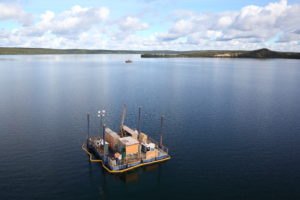In the next two or three weeks, the drills will be turning at PLS. June has been a busy month completing and compiling the data for several regional grids with radon and ground gravity geophysics surveys.
This is an important step for prioritizing the regional drill targets. With that data in hand, we are excited to get the drills turning in early July.
New Survey
If you’re a Fission shareholder, it may interest you to know that an extensive land based radon survey will focus on the Patterson Lake conductive corridor that includes the EM conductors that are associated with the Triple R deposit and the recently discovered R600W zone.
This survey grid alone will cover an approximately 7km2 area including the region from the Triple R’s R00E zone all the way west to the high-grade boulder field. The Patterson Lake conductive corridor trend has already delivered some of the most impressive mineralization in the Athabasca Basin region and by extending our survey to cover the main EM conductors in this corridor we’re looking to identify additional centres of shallow, high-grade uranium.
Drill targeting is critical. Yes, it’s clear to anyone paying attention to the Fission story that we have a very large mineralized system on our hands and, as the R600W zone has recently shown us, it has the potential to be far larger than any of us imagined. Despite the size of the system, one of the biggest factors in our technical team’s success has been our systematic approach and expertise with survey analysis and drill targeting.
The surveys are already underway, as are preparations to prep the site for an aggressive summer drill program. There are many great things about having such a shallow system of mineralization, not least of which is that we can afford to drill a large number of holes within the time and budget allotted – in this case it will be approximately 60 holes in a 20,000 metre, $10M program.
With so many holes at our disposal, we can target numerous areas and to me, that’s what makes this program one of the most exciting we’ve run in the last two years. So, what exactly will we be concentrating on?
Growing the R600W zone has the top billing, with a planned 20 holes focusing on this remarkable high-grade zone located along strike over half a kilometer from the Triple R deposit. This winter saw the discovery of wide, high-grade mineralization at very shallow depths at this land-based zone. Interestingly, the geology of the zone bears remarkable similarities to the Triple R’s R780E zone and, with the zone being open in every direction, we have plenty to follow up on.
More on Triple R
Naturally we’ll also be looking to grow the Triple R deposit. With continued drill success we’re confident that we can add more high-grade pounds to both the indicated and the inferred categories. Of course, the emphasis will be on indicated as that’s by far the most reliable resource estimate category. If you’re not familiar with the difference between indicated and inferred, I’ve covered it in this post.
Next on the list is the R1620E zone. This sits at the far eastern end of our 2.27km mineralized trend. As is the case with the R600W zone, the R1620E zone is open in all directions and, as our recent assays confirmed, there is potential to connect the zone with the Triple R deposit. It may not happen this drill program, as there remains a 330m gap, but we’re keen to see how this zone shapes up. As we saw at R600W, PLS has a tendency to surprise us with the speed at which zones can grow and the strength of grades they can deliver.
The fourth area of focus is regional exploration. We’ll be using 20 holes to target a number of highly prospective regional targets, with the help of radon and ground gravity geophysics. If you check out this map you can see the main location for the regional holes.
We still have some more assays due from the winter program so stay tuned for upcoming news and of course we’ll let you know as soon as we start getting the summer drill results.
Fission Uranium and Dev Randhawa
Dev Randhawa is the founding Chairman and CEO of Fission Uranium. He has won numerous awards for his work in the industry, including Northern Miner Magazine ‘Mining Person of the Year 2013’ and as part of the Fission team, Mining Journal Excellence Award 2015 for Exploration.
Disclaimer
Forward-Looking Information: Some of the posted entries on the blog may contain forward-looking statements. Please find the full disclaimer here.







